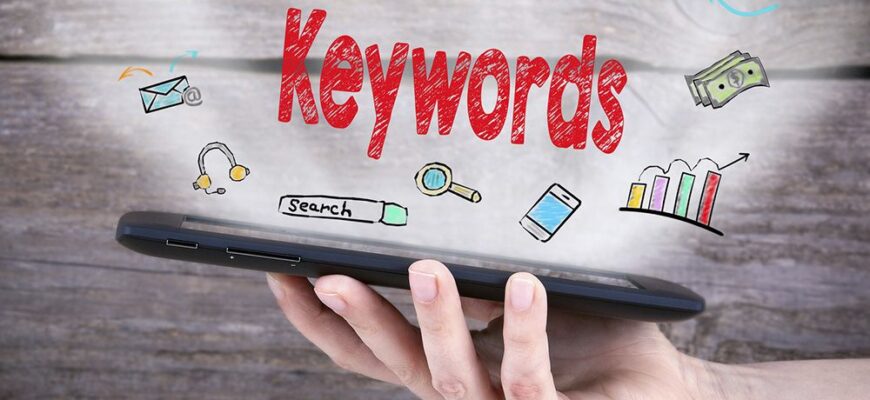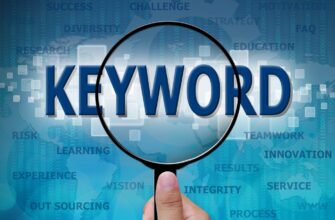- What is a semantic core for contextual advertising?
- Why is it important to collect high-quality semantics for an advertising campaign?
- Main ways of collecting semantics for contextual advertising
- How to compile a semantic core for an advertising campaign?
- Collecting token queries
- Using the keyword planner from Google Ads
- Using automation tools
- Unloading semantics from Google Analytics
- Peeking at competitors
- Watching search hints
- Cleaning the list of key phrases
- Features of compiling a semantic kernel for Google CMMS
- How to divide the semantic kernel into groups?
- Manual clustering
- Automated grouping
- What mistakes are made when collecting semantics for contextual advertising?
To get good results from running online advertising, you need resources and time to optimize it. But one of the most important stages in setting up any campaign is the compilation of a semantic core for contextual advertising.
It is competent work in this direction is the key to high efficiency of the campaign. Poorly selected semantics will consume huge resources without adequate returns.
What is a semantic core for contextual advertising?
Semantic core is a well-thought-out list of words and phrases that you will later use to display ads. The quality and completeness of semantics directly affects the effectiveness of the entire marketing campaign.
The core, in fact, reflects the interests and needs of the audience, its language and the logic of searching for the necessary goods and services on the Internet. That is why its collection – the first and very important stage in the launch of contextual advertising. At this stage, you need to maximize the collection of all possible keywords that potential customers will enter into the search box.
How many calls and sales will I get by ordering contextual advertising from you?
I need to calculate the conversion of my website Describe
the task
in the application
Calculate potential ad revenue Google
contextual advertising calculator
It is not enough just to collect words on the topic, it is also necessary to cluster them correctly. Queries should be grouped by similarity. For example, “buy a refrigerator”, “refrigerators prices”, “order a refrigerator with delivery” have a clearly expressed intention to buy and should be in the same group. And the phrases “how to choose a refrigerator”, “what to look at when choosing a refrigerator”, “rating of refrigerators” – this is another group of keywords that should be redirected to the blog page.
It is also necessary to remove from the core of unnecessary and irrelevant words that formally relate to the topic, but do not reflect interest in the purchase. For example, for an online store of household appliances, such words would be “refrigerator repair”, “refrigerator recycling” and the like.
Another important point is the inclusion of various morphological forms (singular and plural, declension, conjugation) in the core. It will allow to cover more targeted search queries of the audience.
Why is it important to collect high-quality semantics for an advertising campaign?
Competently manage the marketing budget, attract the largest number of targeted visitors allows the selection of effective keywords. But how to collect semantic core for contextual advertising professionally, and what does it give the advertiser?
Professionally selected key queries allow you to receive certain benefits in the future:
- Rejection of uncontroversial queries. In the process of semantic kernel formation, non-commercial keys that do not lead to a deal are cut off. It is impossible to get the maximum number of leads on a high-frequency or unspecific query. For example, if you run an ad for the keyword combination “machine plaster”, then, without paying due attention to minus-words, there is a risk of getting an audience that is looking for “machine plaster how to do it yourself” or “machine plaster photos”. With a careful approach to the formation of semantics such keys are added to minus-words and thus cut off. Potentially effective for obtaining targeted traffic word combinations are not affected;
- Rational budget spending. Qualitatively selected semantics allows you to minimize the number of untargeted clicks on your ad. As a consequence, funds are spent only on those visitors who are interested in the transaction. And forming a list of low-frequency key phrases allows you to collect less competitive and, therefore, cheaper target queries;
- Increasing conversions. Properly formed semantic kernel allows you to maximize the effect of the campaign, which inevitably translates into increased sales;
- Analytics. Subsequent work with the list of word combinations consists in its optimization, because no matter how professionally and scrupulously the queries were selected, there are bound to be some that generate leads worse than others. Analysis using statistics in Google Analytics allows you to identify them and turn them off, as well as to supplement the list of minus-words.
Main ways of collecting semantics for contextual advertising

Collecting a semantic core for contextual advertising can be done in two ways.
The first involves the refusal of special tools to form a list of keys and is based solely on guesses about how users can search for a product. This approach is dangerous. Based only on your own conclusions, you can miss a lot of highly effective keys or include phrases with zero frequency in the semantics.
The second method is to use tools that allow you to assess the real picture – the actual requests of the audience. They help to obtain information about competitors, scrupulously collect semantics and form an exhaustive list of queries. The relevance of advertising with this approach is significantly increased.
Tip! You can increase the impact of an advertising campaign and compile a quality semantic core by combining both approaches.
How to compile a semantic core for an advertising campaign?
To collect key queries, you need to perform several steps, the logical sequence of which is not recommended to change.
Collecting token queries
Markers or group-forming words (they are also called bases or clusters) are words that serve as a source for parsing, during which the main set of phrases or word combinations is selected.
For example, a list collected by the marker “lawnmower” looks like this:
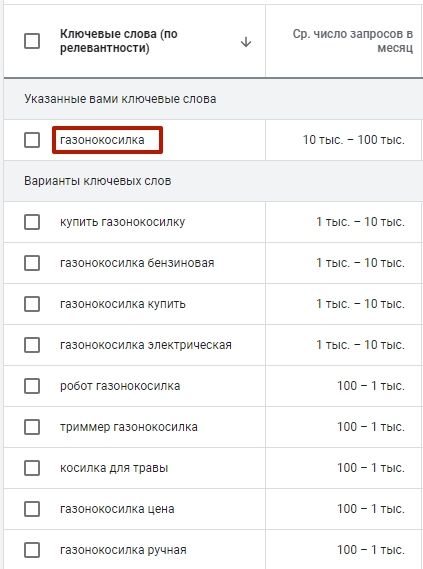
Important! For parsing, you should select all variants of phrases used for the purpose of promotion in contextual advertising for a particular campaign.
As an example, for gardening equipment, the markers are “cultivators”, “trimmers”, “aerators”, etc.
Using the keyword planner from Google Ads
In the “Tools and Settings” block of this service, there is a tool called “Keyword Planner”. You can use it for free.

You can form the list of keys in two ways:
- Set the base words yourself;
- Enter the domain of the Internet resource or the address of a separate page.
Here you can also find data on the average monthly number of requests and the level of competition for them:
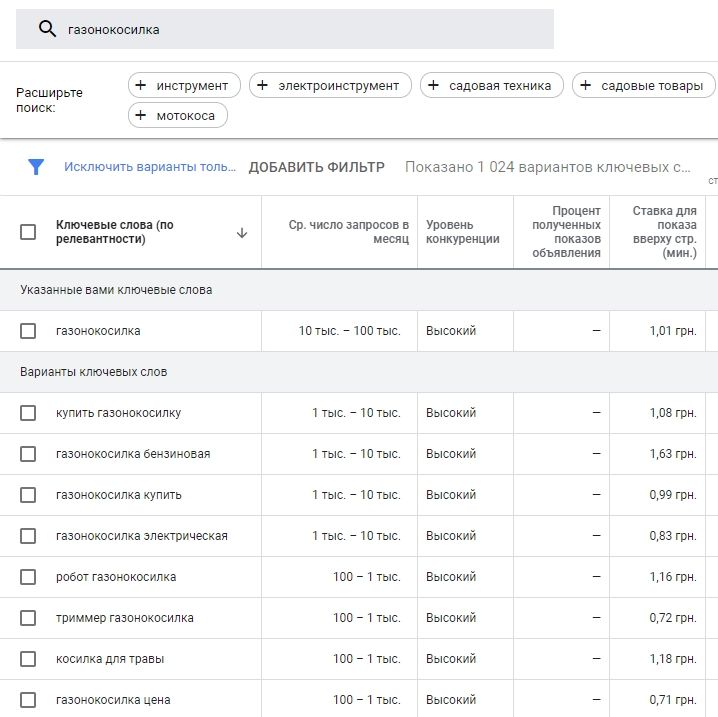
Using automation tools
It takes time to collect keywords manually using the Google Ads scheduler. Special automation services can help you save resources. Such tools help to group not only key phrases in a table, but also add competition and frequency indicators to it.
Key Collector is one example of such programs. The tool is paid and offers extensive functionality for those who deal with semantics on a professional level and deal with kernels containing more than half a thousand keys.
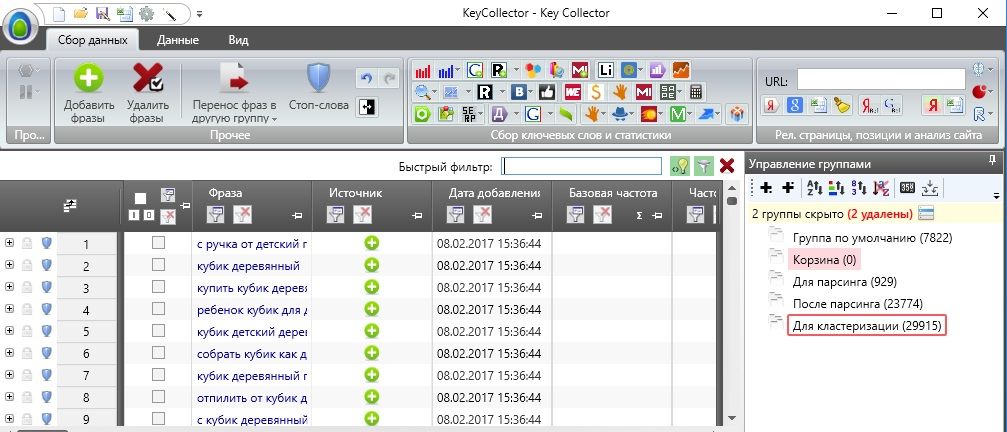
The software allows you to quickly sparse and collect frequencies. From it you can quickly unload a ready array of data for further work, but the tool itself is available only within one device.
How many calls and sales will I get by ordering contextual advertising from you?
I need to calculate the conversion of my website Describe
the task
in the application
Calculate potential ad revenue Google
contextual advertising calculator
Unloading semantics from Google Analytics
To compose a semantic core for contextual advertising, you can use the accumulated statistics on organic traffic by exporting queries for the largest possible period of time from Google Analytics to Excel. To do this, you will need to link your Analytics and Search Console accounts. This feature is then available in the “Queries” sub-section of Search Console under the “Traffic Sources” menu.

Peeking at competitors
The method with the unloading of keys from organics is applicable only to sites with a history. If the resource is new, and such traffic does not yet exist, you can use information about the requests of competing companies.
Several services help in this. The most convenient for Google Ads is to use the Serpstat service. It has the most complete database of keywords in Russian from both paid and organic Google.
Serpstat allows you to analyze competitors, contextual ads and semantics on them. The service can work from different devices in multi-user mode, so it is suitable for those who plan to use it in a team.
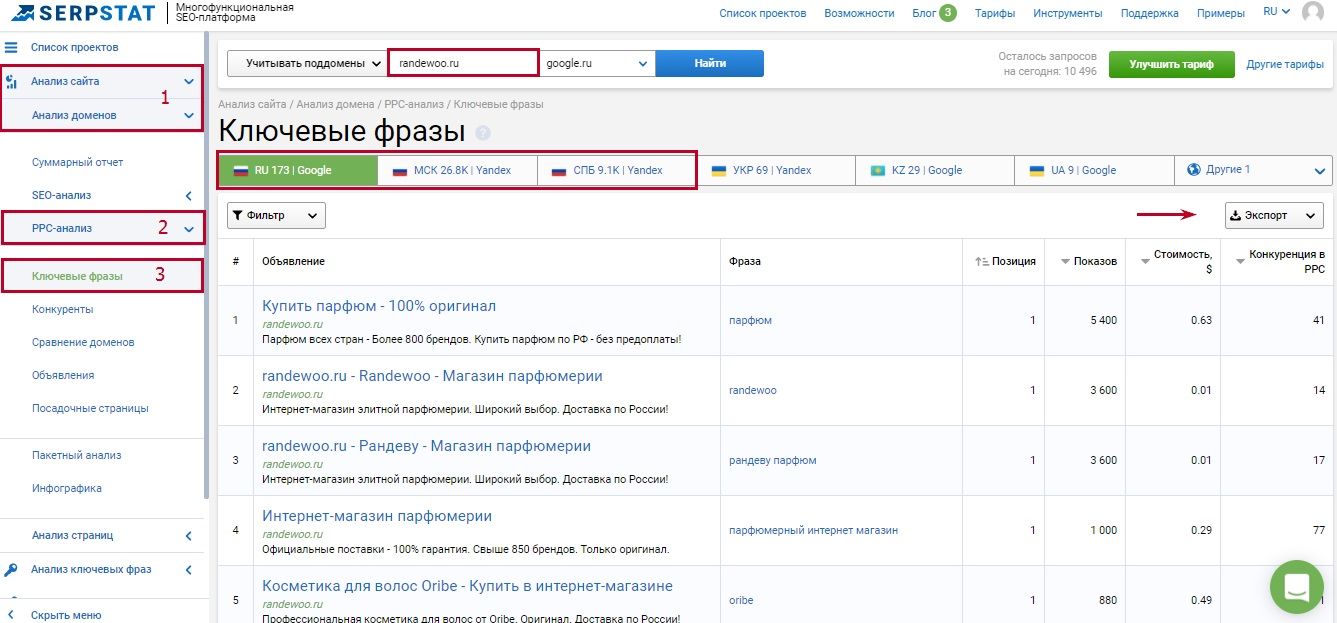
Watching search hints
Search hints are an unobvious but very good source for adding semantics. They can be uploaded using special programs or directly from Google search results.

Both programs described above – Key Collector and Serpstat – have the corresponding functionality.
Cleaning the list of key phrases
After collecting the core, you need to clean it up. This is necessary to remove irrelevant, ineffective and non-commercial keywords. The main stages of cleaning:
- Removing “garbage” and stop words. This is a large group of words and symbols – interjections, prepositions, numbers, typos, punctuation marks. As a rule, they do not affect the meaning of the phrase and are not taken into account when displaying ads. They can be removed manually or with the help of special programs like KeyCollector.
- Exclusion of irrelevant words. For example, if you set up advertising for women’s clothing, the keys “men’s shirts” or “children’s dresses” will be superfluous, although they belong to the category of clothing. Accordingly, they should be removed.
- Cleaning implicit doubles. These are phrases that include the same words in a different order. For example, “buy iPhone” and “iPhone buy”. Essentially, it is the same thing, so it is better to delete the double.
- Delete key phrases with repetitions of words. They do not carry additional meaning and are not needed for advertising. The aforementioned KeyCollector has a separate filter for this.
- Filtering by frequency. Depending on the campaign goals and budget, you can remove a part of high-frequency or low-frequency keys. For example, clean microfrequencies with up to 10 impressions per month.
- Manual cleaning of slang, errors, obscene and irrelevant expressions that remained after automatic cleaning.
Also at the cleaning stage minus-words are collected. These are the words that you do not want to show up in the search, as they will bring untargeted traffic. For example, for an online electronics store, the minus words would be “free”, “handmade”, “used”, “manual”, etc. Minus-words are then uploaded to Google Ads, so that the algorithms do not show ads for queries containing these words.
Features of compiling a semantic kernel for Google CMMS
Formation of semantic kernel for KMS has its own peculiarities. It is important to remember the following rules:
- For advertising in KMC there is no need to collect low-frequency phrases, because in this network search queries as such are absent;
- The use of minus-words should be extremely careful, as they can greatly reduce traffic;
- When setting up displays in KMC, use broad matching – phrase and exact match will significantly reduce the number of displays.
How to divide the semantic kernel into groups?
After collecting and cleaning the core, the next step is to divide the words into groups or clusters. This is necessary for more accurate targeting of advertising, increasing its relevance and effectiveness.
Core clustering means grouping phrases according to their meaning, user intent and priority for the advertised business. Words in one group should be as close in meaning as possible, so that a single relevant ad can be written under them.
For a better understanding, here are the main approaches and criteria that are used to cluster semantics:
- By stage of the sales funnel or goal. There are informational (to learn something), transactional (to buy) and navigational (to get to a particular site) keys. Accordingly, these types of queries should be divided into different groups. For example, “buy a phone” and “how to choose a phone” will fall into different clusters.
- By commercial triggers – words that clearly indicate readiness to buy or order. For example, “price”, “buy”, “order”, “delivery”. It makes sense to prioritize them so that you can assign them the highest display rates.
- By categories, subcategories of goods and individual brands/models. Division according to the principle from general to specific. For example, for an electronics store, the groups can be as follows: “smartphones” (general category), “xiaomi smartphones” (brand), “xiaomi 14” and “xiaomi 14t pro” (specific models).
- By additional parameters and characteristics. For example, for clothes it is color, size, material, style, season. For hotels – star rating, type of food, location. If there are enough keys for each parameter, they can be allocated to a separate group.
- By price ranges of goods – “cheap”, “inexpensive”, “premium”, “luxury”, etc. This allows you to make more accurate price positioning in your ads.
- By geolocation – cities/regions, if we are talking about local business. For example, “buy flowers in Kiev”, “sushi delivery in Ivano-Frankivsk”.
Once the basic principles of division have been determined, you can proceed to the actual clustering. This can be done manually in Excel or Google tables, or you can use special services and programs that automate the process (for example, KeyAssort). It is most effective to combine both approaches.
As a result, each group of keywords will correspond to a certain meaning. It is then used to create relevant and optimized variants of advertisements and landing pages on the site.
This increases clickability, as the user sees exactly what he or she is looking for in the title and description. The conversion rate of the website is also improved, as the visitor arrives at the page that best suits his request and intent.
Manual clustering
Manual clustering is the most reliable and accurate method that allows you to take into account the nuances and specifics of the business. An experienced specialist can qualitatively separate the keys, understanding what ad and landing page will need to be created for them.
Manual clustering requires time and labor. For semantic kernels with a couple hundred keywords, this is still possible. But when there are tens of thousands of them, grouping them manually will take weeks. This is critical if the advertising launch is planned in a short period of time.
Automated grouping
For large semantic kernels, it makes sense to use automated tools and services. They analyze keys and group them in minutes. This significantly speeds up the process and saves resources.
But autogrouping has a significant disadvantage – algorithms may assign keys to the wrong group due to the presence of common words. They do not always take into account the context and the real meaning of the query.
For example, the query “buy a leather bag” may fall into the general group “bags”, although it is more logical to use “leather bags”. The ad for the general group “bags” will not be as relevant for this key, and the landing page of the main category with bags made of different materials will obviously collect fewer conversions than a separate URL with leather bags.
Among the tools for automated grouping you can use a free service from SeoQuick or its analog from SerpStat with advanced features. When using such services, it is advisable to manually check and correct the resulting groups.
The optimal approach is a combination of automatic and manual grouping. First, semantics is run with special tools that do the initial sorting and splitting. Then the specialist manually checks the groups, redistributes erroneously attributed keys, splits common clusters into narrower ones.
What mistakes are made when collecting semantics for contextual advertising?
PPC beginners most often make the following mistakes when collecting a semantic core:
- Focusing on HF queries. Many beginners chase the most popular words with a high number of impressions. But the competition for these words is usually high, which translates into an inflated cost per click. And it is not certain that a user who clicked on such a general query will make a targeted action. It is more optimal to use a mix of high-, medium- and low-frequency keys.
- Ignoring low-frequency queries. Some of them give a much higher conversion rate than HF. Especially phrases that contain a lot of qualifying words that specify the user’s question. If you offer a client the most relevant landing page possible, he will make a purchase with a high probability. Plus the price of a click on low frequency is usually lower due to less competition.
- Creating separate landing pages for the keys. In pursuit of the exact match of ads and landings to queries, sometimes advertisers begin to breed dozens and hundreds of URLs that differ literally, one word in the title. It is much more effective to create groups of meaning and drive traffic to a single landing page optimized for a cluster of similar queries.
- Abuse of automation. Various services and programs (the same Key Collector) really make your work much easier and faster. But you should not rely on them blindly, especially at the cleaning and grouping stages. Algorithms may make mistakes and collect irrelevant data. It is important to analyze and work through the keyword database manually, and use tools as an aid.
- Mimicking competitors. Services like SemRush or Serpstat allow you to see the queries used by competitors’ sites. Yes, this will save time in gathering basic semantics. But you can’t copy someone else’s core completely. Information from competitors may be irrelevant to your business for various reasons – differences in assortment, sales region, target audience, etc. Other people’s semantics should be carefully filtered and adapted.
- Collecting semantics without taking into account the target audience. Before you start collecting keys, make a detailed portrait of your target audience – who your ideal clients are, what they are looking for, what language they speak, and so on. This will allow you to include the maximum number of keys that reflect the real needs of your customers. If you collect keys without looking at the target audience, you can get traffic that won’t convert into sales.

